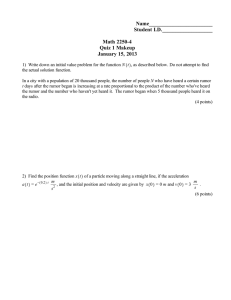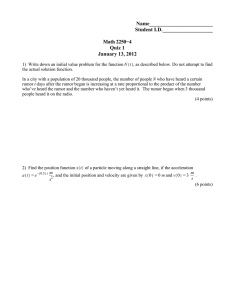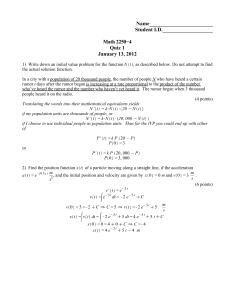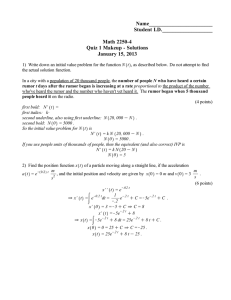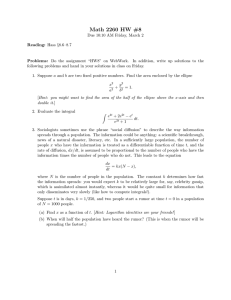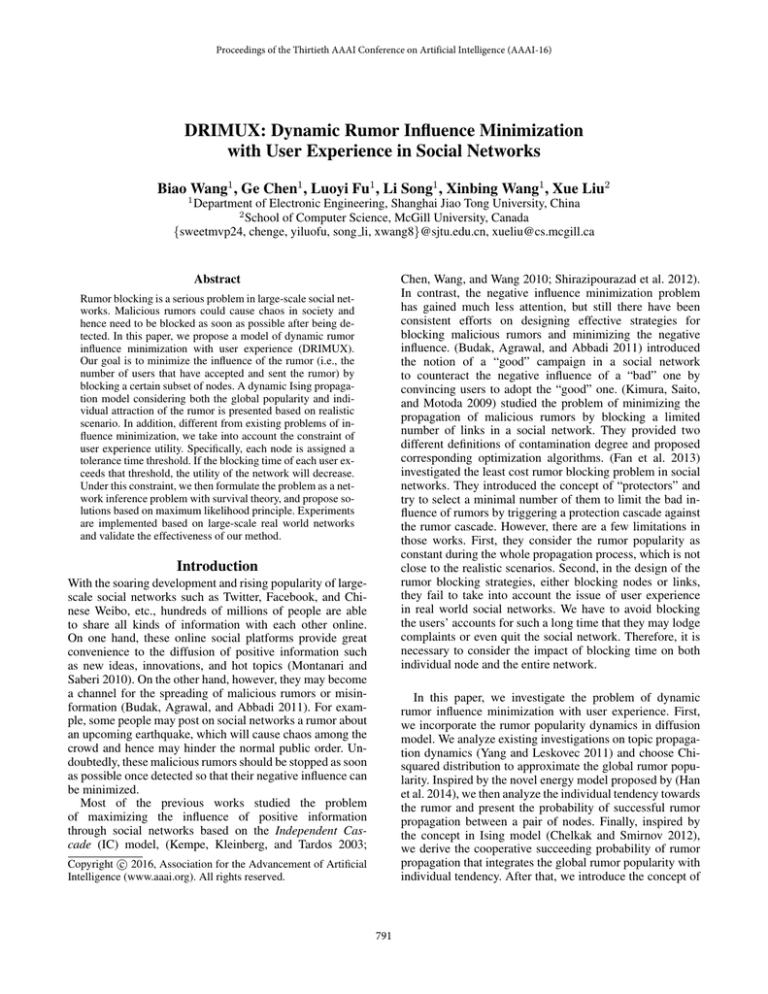
Proceedings of the Thirtieth AAAI Conference on Artificial Intelligence (AAAI-16)
DRIMUX: Dynamic Rumor Influence Minimization
with User Experience in Social Networks
Biao Wang1 , Ge Chen1 , Luoyi Fu1 , Li Song1 , Xinbing Wang1 , Xue Liu2
1
Department of Electronic Engineering, Shanghai Jiao Tong University, China
2
School of Computer Science, McGill University, Canada
{sweetmvp24, chenge, yiluofu, song li, xwang8}@sjtu.edu.cn, xueliu@cs.mcgill.ca
Chen, Wang, and Wang 2010; Shirazipourazad et al. 2012).
In contrast, the negative influence minimization problem
has gained much less attention, but still there have been
consistent efforts on designing effective strategies for
blocking malicious rumors and minimizing the negative
influence. (Budak, Agrawal, and Abbadi 2011) introduced
the notion of a “good” campaign in a social network
to counteract the negative influence of a “bad” one by
convincing users to adopt the “good” one. (Kimura, Saito,
and Motoda 2009) studied the problem of minimizing the
propagation of malicious rumors by blocking a limited
number of links in a social network. They provided two
different definitions of contamination degree and proposed
corresponding optimization algorithms. (Fan et al. 2013)
investigated the least cost rumor blocking problem in social
networks. They introduced the concept of “protectors” and
try to select a minimal number of them to limit the bad influence of rumors by triggering a protection cascade against
the rumor cascade. However, there are a few limitations in
those works. First, they consider the rumor popularity as
constant during the whole propagation process, which is not
close to the realistic scenarios. Second, in the design of the
rumor blocking strategies, either blocking nodes or links,
they fail to take into account the issue of user experience
in real world social networks. We have to avoid blocking
the users’ accounts for such a long time that they may lodge
complaints or even quit the social network. Therefore, it is
necessary to consider the impact of blocking time on both
individual node and the entire network.
Abstract
Rumor blocking is a serious problem in large-scale social networks. Malicious rumors could cause chaos in society and
hence need to be blocked as soon as possible after being detected. In this paper, we propose a model of dynamic rumor
influence minimization with user experience (DRIMUX).
Our goal is to minimize the influence of the rumor (i.e., the
number of users that have accepted and sent the rumor) by
blocking a certain subset of nodes. A dynamic Ising propagation model considering both the global popularity and individual attraction of the rumor is presented based on realistic
scenario. In addition, different from existing problems of influence minimization, we take into account the constraint of
user experience utility. Specifically, each node is assigned a
tolerance time threshold. If the blocking time of each user exceeds that threshold, the utility of the network will decrease.
Under this constraint, we then formulate the problem as a network inference problem with survival theory, and propose solutions based on maximum likelihood principle. Experiments
are implemented based on large-scale real world networks
and validate the effectiveness of our method.
Introduction
With the soaring development and rising popularity of largescale social networks such as Twitter, Facebook, and Chinese Weibo, etc., hundreds of millions of people are able
to share all kinds of information with each other online.
On one hand, these online social platforms provide great
convenience to the diffusion of positive information such
as new ideas, innovations, and hot topics (Montanari and
Saberi 2010). On the other hand, however, they may become
a channel for the spreading of malicious rumors or misinformation (Budak, Agrawal, and Abbadi 2011). For example, some people may post on social networks a rumor about
an upcoming earthquake, which will cause chaos among the
crowd and hence may hinder the normal public order. Undoubtedly, these malicious rumors should be stopped as soon
as possible once detected so that their negative influence can
be minimized.
Most of the previous works studied the problem
of maximizing the influence of positive information
through social networks based on the Independent Cascade (IC) model, (Kempe, Kleinberg, and Tardos 2003;
In this paper, we investigate the problem of dynamic
rumor influence minimization with user experience. First,
we incorporate the rumor popularity dynamics in diffusion
model. We analyze existing investigations on topic propagation dynamics (Yang and Leskovec 2011) and choose Chisquared distribution to approximate the global rumor popularity. Inspired by the novel energy model proposed by (Han
et al. 2014), we then analyze the individual tendency towards
the rumor and present the probability of successful rumor
propagation between a pair of nodes. Finally, inspired by
the concept in Ising model (Chelkak and Smirnov 2012),
we derive the cooperative succeeding probability of rumor
propagation that integrates the global rumor popularity with
individual tendency. After that, we introduce the concept of
c 2016, Association for the Advancement of Artificial
Copyright Intelligence (www.aaai.org). All rights reserved.
791
Related Work
user experience utility function and analyze the impact of
blocking time of nodes to the rumor propagation process.
We then adopt the survival theory to explain the likelihood
of nodes getting activated, and propose both greedy and dynamic algorithms based on maximum likelihood principle.
The rest of the paper is organized as follows: First, we
introduce the preliminaries; then we give an overview of the
related work; after that, we propose the problem formulation
and the solutions; experiments are presented in the following
section; and finally, the paper is concluded.
Topic Dynamics
Researchers have studied the temporal dynamics of web
topics based on real-world statistics. (Yang and Leskovec
2011) analyzed how the number of tweets related to a
specific theme (i.e., the popularity of a topic) changes with
time, and revealed that a topic evolution generally consists
of three phases, i.e., a rising phase from the start, a peak
period and then a fading phase. Fluctuations in each phase
may result in different temporal characteristics. (Yang and
Leskovec 2011) proposed K-Spectral Centroids clustering
algorithm for classifying online content according to their
temporal patterns and finally extract six representative
patterns from million-scale tweets and blog posts. (Crane
and Sornette 2008) demonstrated the existence of Poisson
distribution and Power-law relaxation in controlling the
topic evolution over time. In our work, we use the Chisquared distribution to simulate the rumor propagation
dynamics.
Preliminaries
Social Network Definition
A social network, in mathematical context, can be formulated as a directed graph G = (V, E) consisting of a set of
nodes V representing the users, and a set of directed edges
E denoting the relationship between users (e.g. following or
being followed). Let |V | = N denote the number of nodes,
and (u, v) ∈ E denote the directed edge from node u to node
v (u, v ∈ V ), and αuv ∈ {0, 1} denote the edge coefficient,
where αuv = 1 represents the existence of edge (u, v), and
αuv = 0, otherwise. We use puv to denote the probability of
u sending the rumor to v and v accepting it, i.e., the success
probability of u activating v. Let D(u) denote the in-degree
of node u.
Energy Model
(Han et al. 2014) proposed a novel energy model to describe
the rumor propagation process. They introduce the heat energy calculation formula ΔE = cmΔT in Physics to analogize the rumor impact. The rumor’s influence on individual
node is formulated as the amount of accumulated heat energy. Inspired by the simulated annealing algorithm (Bertsimas and Tsitsiklis 1993), they define the rumor’s attraction
to the nodes as an annealing process. Based on the model,
we define the individual tendency with the success activation probability between a pair of nodes
Diffusion Model
Diffusion models describe the process of information propagating through the network. Two classic diffusion models
are Linear Threshold (LT) and Independent Cascade (IC)
model. In LT model, an inactive node u becomes activated if
the ratio of its activated parent nodes surpasses a certain predefined threshold 0 < θ < 1. Although it indicates a latent
tendency of a node becoming activated when its neighbors
do, the LT model fails to consider the individual difference
of each node in a social network. Therefore, we adopt the
more complex IC model in our work.
The IC model has been widely adopted in information diffusion problems. The whole propagation process proceeds in
discrete time steps t0 , t1 , t2 , . . . . Initially, the cascade is triggered by a set of activated nodes, i.e., the seed nodes at t0 . In
our rumor diffusion context, we assume the rumor is started
by one source node s in the network, and the other nodes are
inactive. We use su (t) ∈ {0, 1} to denote the state of node u
at time step t, where su (t) = 1 represents u is activated and
su (t) = 0, otherwise. For every following time step t ≥ 1,
each node u which was activated at time step (t − 1) has
a single opportunity to activate any of its currently inactive
neighbors v with a success probability puv . In our context,
it means in each time step, any node that has accepted the
rumor in previous time step has a chance to let their inactive
neighbors accept the rumor. For simplicity, we assume that
once a node is activated by the rumor, it will stay activated
until the end of the diffusion process.
User Experience
User experience is an important factor for various services
including social networks. Existing rumor blocking strategies block either nodes (users) or links (connections between users) in social networks to prevent the rumor from
further propagation. However, none has analyzed the impact of blocking nodes. Generally speaking, the longer the
user is blocked, the less satisfactory the user feels about the
social network. Therefore, if the blocked time surpasses a
certain threshold, it is possible that the user may quit the
social network or at least lodge a complaint to the administrator. (Bhatti, Bouch, and Kuchinsky 2000) analyzed the
user-perceived quality in web server design and found that
users’ tolerance for latency decreases over the duration of
interaction with a site. A utility function was presented to
measure the customer satisfaction. Inspired by that, in our
work, we apply a modified utility function to measure user
experience in rumor blocking.
Rumor Influence Minimization
Rumor influence minimization addresses the problem of
minimizing the propagation effect of undesirable rumors in
social networks. It is converse to the classic influence maximization problem (Kempe, Kleinberg, and Tardos 2003).
The rumor influence minimization (RIM) problem has been
792
investigated in different influence diffusion models in social networks. (Fan et al. 2013) studied the least cost rumor
blocking problem in social networks, and introduced the notion of “protectors” to limit the bad influence of rumors by
initiating a protector cascade to propagate against the rumor
cascade. Greedy algorithm is proposed for both opportunistic and deterministic cascade models. However, (Kimura,
Saito, and Motoda 2009) proposed the strategy of blocking
links instead of nodes in social networks so as to minimize
the propagation of malicious rumors. Different contamination minimization problems are defined based on different
definitions of contamination degree of a network.
atmosphere” that could affect the judgements or decisions of
users on online social networks.
According to the Ising model (Chelkak and Smirnov
2012), the “phase transition” of a spin involves both shortrange interaction with its nearest neighbors and long-term
system evolution, and is a cooperative result. Inspired by
that, we propose the cooperative propagation probability integrating pglb (t; k) with pind (t) as
puv (t) =β1 · pglb (t; k) + β2 · pind (t)
Problem Formulation
(Kempe, Kleinberg, and Tardos 2003) considered the success probability puv as a system parameter and is fixed at
the very first beginning of the cascade. However, based on
the topic dynamics we discussed in a previous section, at
different time steps of the propagation process, a topic can
vary dramatically in its popularity. Besides, the rumor attraction (Han et al. 2014) for each individual node u ∈ V
is also a realistic factor we should take into account. That
means the success of rumor propagation between neighbors
includes two aspects: first, the activated node u has to be
so attracted by the rumor that it will choose to send the rumor to its neighbors; second, one of u’s inactive neighbors
v decides to accept the rumor. Only after those two steps,
can we claim that v is activated. In other words, the success
of rumor propagation depends both on the global popularity
and the individual tendency of the rumor topic, which can
be regarded as a generalized feature of the Ising model.
Now we investigate the two steps of a successful rumor
propagation. In the first step, at any time stamp tj , u is one of
the activated nodes in time stamp (tj −1). Based on the work
in (Han et al. 2014), we give the modified version of the
probability of node u sending the rumor to one of its inactive
p0
neighbors v as psend
u (tj ) = lg(10+tj ) , where p0 is the initial
sending probability at time stamp 0. The probability of node
v accepting the rumor is also given as pacc
v = 1/Dv , where
Dv is the in-degree of node v. Thus, we give the probability
of successful rumor propagation from u to v as
p0
1
,
Dv lg(10 + tj )
u∈Pv
where P r[·] represents probability, and Pv represents the
parent nodes of v.
User Experience Utility
Before giving the concrete algorithm, we first elaborate
on the user experience utility function (Bhatti, Bouch, and
Kuchinsky 2000).
For simplicity, we assume that all the nodes have the same
blocked time threshold Tth . In other words, we assume that
all users have the same tolerance when being blocked. Under
this assumption, we define the user experience utility function as
N
1 Tth − Tb (u)
,
(5)
Ub =
N u=1
Tth
where the Tth represents the tolerance time threshold, Tb (u)
is used to record the blocked time of node u in the whole
propagation process.
Objective Formulation
(1)
Now our goal is to minimize the influence of a rumor as
much as possible (e.g. minimize the number of activated
nodes at the end of propagation process) under the constraint
of user experience utility. We formulate the DRIMUX problem as follows:
which can be defined as the individual tendency between different pair of nodes in the network.
Now we discuss the global topic popularity of the rumor.
As mentioned in related work, the rumor popularity generally includes three phases and approximately subject to the
chi square distribution, which is given by
k
2(1− 2 ) tk−1 e
pglb (t; k) =
Γ( k2 )
2
− t2
min
E[
sv (tth ) ]
v∈V
,
(3)
where β1 , β2 ∈ (0, 1) are the balance coefficients which satisfy β1 + β2 = 1.
Based on this cooperative propagation probability, the
probability of node v getting activated at time stamp tj can
be given by
P r[sv (tj ) = 1] = 1 −
[1 − su (tj−1 )puv (tj )], (4)
Dynamic Rumor Propagation with Ising Model
· pacc
pind (tj ) = psend
u
v =
t2
k
2(1− 2 ) tk−1 e− 2
1
p0
+ β2
=β1
,
Dv lg(10 + tj )
Γ( k2 )
s. t.
(2)
(6)
Ub ≥ Uth ,
where tth represents the time instant when the user experience utility Ub just triggers the threshold Tth , and it determines the observation time window T that we are going to
discuss in the following section.
where k > 0 represents the degree of freedom, Γ(·) is the
Gamma function. It explains a common social phenomenon
that when a rumor spreads for a while, it may create a “rumor
793
where S (t) is the derivative of S(t). Accordingly, we can
have
t
(11)
S(t) = e− 0 αv (τ |s(τ ))dτ ,
and for a certain node v, we have
Proposed Solutions
In this section, we analyze the DRIMUX optimization problem from the perspective of a network inference problem
with survival theory and then propose the greedy algorithm
and dynamic blocking algorithm based on different nodes
selection schemes and the maximum likelihood principle.
Fv (t|s(t)) = 1 − e−
In our model, we assume that the rumor has spread for some
time, and it is detected at time t0 by the system. It is also assumed that by time t0 , there have already been a total number of N1 activated nodes, and N2 = N − N1 nodes are
remain inactive. Let VN1 and VN2 denote the set of activated
and inactive nodes at time t0 respectively. Therefore, from
t0 on, the system can be viewed as N1 independent cascades
propagating through the network, and our goal is to select
K nodes and block them so that the final number of activated nodes during the observation time window T can be
minimized. Let C = (c1 , . . . , cN1 ) denote the set of cascades triggered by N1 activated nodes by time t0 . A cascade
ci ∈ C can be represented by a N -dimensional time vector
tci = (tc1i , . . . , tcNi2 ) where tcji ∈ [t0 , t0 + T ] ∪ {∞}, j =
1, 2, . . . , N2 is the activated time of node j in cascade ci .
The observation time window T is decided by the user experience utility constraint mentioned in (6), and ∞ means the
node is not activated until the end of the observation time
(t0 + T ).
Here we consider only one cascade and the results can
be extended to multiple cascades. Define αv (t|s(t)) as the
hazard rate of node v conditioned on the set of nodes activated by time t. Our goal now is to analyze the impact of the
hazard rate of different nodes to the rumor influence minimization problem.
.
(12)
where αv = (αuv ), u = 1, 2, . . . , N is a non-negative parameter vector indicating the existence of the edge between
node u and v. αuv = 1 if there is an edge between them; and
αuv = 0, otherwise.
×N
to
We define a coefficient matrix A := [αv ] ∈ RN
+
denote the structure of network, and A0 be the original network coefficient matrix before any nodes are blocked. Then
we calculate Fv (t|s(t)) as:
Fv (t|s(t)) =1 − e
=1 − e
=1 −
−
−
t
tu
u:tu <t
t
u:tu <t
tu
αuv puv (τ )dτ
αuv puv (τ )dτ
e−αuv
t
tu
puv (τ )dτ
.
(14)
u:tu <t
Accordingly, we have the likelihood function of the activation of node v, fv (t|s(t)), as following:
−αv t pv (τ )dτ
t
fv (t|s(t)) =
αuv puv (t)
e
.
u:tu <t
:t <t
(15)
Given the activation likelihood of a single inactive node
v ∈ VN2 , now we consider any number of inactive nodes in
a cascade. During the entire observation window T , t≤T =
(t1 , . . . , ti , . . . , tN |t0 ≤ ti ≤ t0 + T ). We assume that every
activation is conditionally independent on activations occurring later given previous activations. Then we can compute
the activation likelihood as:
f (t≤T ; A) =
αuv puv (ti )×
(7)
where T is the occurrence time of an event of interest, t
is some specified time. The survival function represents the
probability that the event of interest occurs after the observation “deadline”. If we use the terminology “death” to represent the occurrence of the event, we can claim that the target
“survives”. Then we have the cumulative distribution function F (t):
i:ti <T u:tu <ti
e
−αv
ti
t
pv (τ )dτ
.
(16)
:t <ti
(8)
Based on the activation likelihood function, we design the
blocking algorithms. First, we choose to select and block
all K nodes at the same time t0 . As is shown in Eq. (16),
the activation likelihood of an inactive node v is related to
the hazard rate coming from all previously activated nodes.
Therefore, the early activated nodes play a significant role in
the entire process. Hence, we propose the following greedy
algorithm to minimize the influence of the rumor within one
time stamp after it is detected. We assume that there are M
time steps: t1 , . . . , tM during the whole observation window
T , with each time step lasting T /M .
Greedy Algorithm. At time t0 when we detect the rumor,
Accordingly, the probability density function f (t) is given
by
d
(9)
f (t) = F (t).
dt
Hazard Rate The hazard rate which characterizes the instantaneous rate of occurrence of an event is defined as:
P r(t ≤ T ≤ t + dt|T > t)
dt
S (t)
=−
,
S(t)
αv (τ |s(τ ))dτ
u:tu <t
Survival Function First, we introduce the survival function defined as (Aalen, Borgan, and Gjessing 2008)
F (t) = P r(T ≤ t) = 1 − S(t).
0
Based on the survival analysis, we propose an additive survival model where the hazard rate is given by
αv (t|s(t)) = αTv s(t) =
αuv puv (t),
(13)
Survival Theory
S(t) = P r(t < T ),
t
αv (t|s(t)) = lim
dt→0
(10)
794
we immediately select K nodes and block them, trying to
minimize the likelihood of nodes getting activated at t1 . The
likelihood of nodes getting activated at time t1 is given by
f (t1 |s(t0 )) =
αuv puv (t1 )×
v∈VN2 u:tu ≤t0
e
−αv
t1
t
pv (τ )dτ
.
to block based on the Edge matrix and previously infected
nodes; in the next round, we move forward with the rumor
diffusion, and then use the updated status to block additional
k2 nodes. The blocking process continues at each following
instants until the
budget runs out at a moment tn , which can
n
be expressed as j=1 kj = K. In real implementation, we
decrease kj as time goes by, and a practical example is kj =
2(−j) ∗ K.
Instead of blocking K candidates at the moment of detection, as previous static blocking strategies do, this dynamic
approach is carried out in a progressive way. The design philosophy is to take advantage of instantaneous information all
along the dissemination, since this the activation likelihood
of a given moment is a variable which depends on the temporal Edge matrix and previous status. Rather than sparing
all the efforts at once, we apply consequent force to block
the diffusion of rumors. In this way, the global efficiency
outweighs the previous static decisions.
(17)
:t ≤t0
Correspondingly, the objective function is
min f (t1 |s(t0 ))
A
s. t.
(18)
αuv ∈ {0, 1}.
Then, the greedy algorithm is presented as below:
Algorithm 1 Greedy Algorithm
Input: Initial Edge matrix A0 .
Initialization: VB = ∅.
for i = 1 to K do
u = arg max[f (t1 |s(t0 ); Ai−1 )−f (t1 |s(t0 ); Ai−1 \v)]
Experiments
v∈V
Dataset: Network extracted from the SinaWeibo, with
23086 nodes, and 183549 edges.
Notations: Let Ninit denote the number of initial nodes at
the beginning of the propagation, Tstart denote the time
when the rumor is detected, and Bamount represent the
amount of nodes to be blocked. All the parameters are selected based on empirical results that approximate the realistic scenario. Three algorithms are presented in the experiments for comparison which are listed as follows:
Ai := Ai−1 \u,
VB = VB ∪ {u}.
end for
Output: VB .
Dynamic Blocking Algorithm Different from the greedy
blocking algorithm, the dynamic blocking algorithm blocks
the K nodes in separated steps. In this way, the algorithm
is able to capture the dynamic characteristics along rumor propagation. Correspondingly, the likelihood function
is given by
f (tj |s(tj−1 )) =
αuv puv (tj )×
• Classic Greedy: Greedy algorithm based on descendant
order of nodes degree and is used as the baseline algorithm.
• Proposed Greedy: the order is determined by the maximum likelihood function. By blocking a node, we can
generate a new propagation matrix and reach a new maximum survival likelihood value.
v∈V (tj ) u:tu <tj
e
−αv
tj
t
pv (τ )dτ
,
(19)
:t <tj
where V (tj ) represents the set of nodes which remain inactive at time stamp tj . Based on Eq. (19), the algorithm is
presented as following:
• Dynamic Algorithm: This algorithm adjusts to each
propagation status, and gradually includes new targeted
nodes as long as the cost is within the scope of tolerable
user experience.
Algorithm 2 Dynamic Blocking Algorithm
Input: Initial Edge matrix A0 .
Initialization: VB (t) = ∅.
for j = 1 to n do
for i = 1 to kj do
Δf = f (tj |s(tj−1 ); Ai−1 )−f (tj |s(tj−1 ); Ai−1 \v),
u = arg max{Δf },
In order to simulate a real-scenario dissemination process,
we assign several nodes as rumor initiators at the beginning.
After a certain period of natural propagation, the rumor is
detected by the system and thus we launch our blocking
strategy. The vertical dashed line in every figure marks the
debut of blockage on potential nodes.
In Figure 1, each selected node is blocked for a predefined constant period of time Tb . We repeat the propagation process for 1000 times and take the average value as the
general feature. The black curve stands for Classic Greedy,
blue one for Proposed Greedy, and finally red for Dynamic
Blocking Algorithm. Obviously, the propagation rate is decreased to different degrees after the introduction of blockage. As previewed, according to eventual infection range,
the dynamic algorithm performs the best among these strategies, since the propagation range is minimized at the end of
v∈V
Ai := Ai−1 \u,
VB (tj ) = VB (tj ) ∪ {u}.
end for
end for
Output: VB (t).
The dynamic blocking algorithm runs as follows: at the
very first stage of blocking, we select a number k1 nodes
795
Figure 1: Rumor infection ratio varies along time with
Ninit = 54, Tstart = 12, and Bamount = 64.
Figure 3: Rumor infection ratio varies along time with
Ninit = 32, Tstart = 12, and Bamount = 64.
Figure 2: Rumor infection ratio varies along time with
Ninit = 32, Tstart = 12, and Bamount = 16.
Figure 4: Rumor infection ratio varies along time with different block durations using dynamic blocking algorithm.
propagation under this schema. In the following is our proposed maximum likelihood greedy algorithm, which blocks
all candidates at once and use a metric different from traditional approach. The dynamic property is revealed from the
early stage of rumor blocking. In detail, during the period
[15, 25], the blue curve lies under the red one, which indicates the slower propagation rate for the static schema. This
can be explained by the fact that the dynamic algorithm does
block fewer nodes than the static ones at the first moment.
After certain moments (about 25 iterations), the blue curve
overpasses the red because the dynamic strategy constantly
introduce new seeds for blocking.
Figure 2 and 3 illustrate the blocking efficiency under different costs, i.e., the number of nodes that could be blocked.
It is shown that when the investment is abundant, and we
have enough nodes to block under certain circumstances,
the advantage of our proposed dynamic strategy becomes
more obvious since the subsequent efforts on blockage are
increased and thus more powerful in dealing with variances.
Figure 4 is generated using the dynamic blocking algorithm and reflects the effect of different block durations on
rumor propagation range, i.e., the infection ratio at the end
of the propagation. As is shown in the figure, the longer a
node is blocked, the slower the rumor propagates. This benefit, however, is obtained at the expense of declined user experience. The result helps us to analyze the possibility of
achieving close performance with less cost. It is also noticeable that this result is coherent to our analysis on User
Experience.
Conclusion
In this paper, we investigate the rumor blocking problem in
social networks. We propose the dynamic rumor influence
minimization with user experience model to formulate the
problem. A dynamic rumor diffusion model incorporating
both global rumor popularity and individual tendency is presented based on the Ising model. Then we introduce the concept of user experience utility and propose a modified ver-
796
Kimura, M.; Saito, K.; and Motoda, H. 2009. Blocking links
to minimize contamination spread in a social network. ACM
Transaction on Knowledge Discovery from Data 3:9.
Montanari, A., and Saberi, A. 2010. The spread of innovations in social networks. In Proceedings of the National Academy of Sciences of the United States of America,
20196–20201. PNAS.
Shirazipourazad, S.; Bogard, B.; Vachhani, H.; and Sen, A.
2012. Influence propagation in adversarial setting: How to
defeat competition with least amount of investment. In Proceedings of the 21st ACM International Conference on Information and Knowledge Management, 585–594.
Yang, J., and Leskovec, J. 2011. Patterns of temporal variation in online media. In Proceedings of ACM International
Conference on Web Search and Data Minig, 177–186.
sion of utility function to measure the relationship between
the utility and blocking time. After that, we use the survival
theory to analyze the likelihood of nodes getting activated
under the constraint of user experience utility. Greedy algorithm and a dynamic blocking algorithm are proposed to
solve the optimization problem based on different nodes selection strategies. Experiments implemented on real world
social networks show the efficacy of our method. In our future work, we plan to assign different blocked time thresholds to different nodes and design the corresponding blocking strategies. We will also verify our algorithms on multiple
datasets.
Acknowledgments
This work was partially supported by NSF China
(No. 61532012, 61325012, 61271219, 61221001, and
61428205).
References
Aalen, O. O.; Borgan, Ø.; and Gjessing, H. K. 2008. Survival and event history analysis: a process point of view,
volume 1-16. Springer Verlag.
Bertsimas, D., and Tsitsiklis, J. 1993. Simulated annealing.
Statistical Science 8:10–15.
Bhatti, N.; Bouch, A.; and Kuchinsky, A. 2000. Computer
Networks, volume 1-16.
Budak, C.; Agrawal, D.; and Abbadi, A. E. 2011. Limiting
the spread of misinformation in social networks. In Proceedings of the 20th International World Wide Web Conference,
665–674.
Chelkak, D., and Smirnov, S. 2012. Universality in the 2d
ising model and conformal invariance of fermionic observables. Inventiones mathmaticae 189:515–580.
Chen, W.; Wang, C.; and Wang, Y. 2010. Scalable influence
maximization for prevalent viral marketing in large-scale social networks. In Proceedings of the 16th ACM SIGKDD Internatioanl Conference on Knowledge Discovery and Data
Mining, 1029–1038.
Crane, R., and Sornette, D. 2008. Robust dynamic classes
revealed by measuring the response function of a social system. Proceedings of the National Academy of Sciences of
the United States of America 105:15649–15653.
Fan, L.; Lu, Z.; Wu, W.; Thuraisingham, B.; Ma, H.; and Bi,
Y. 2013. Least cost rumor blocking in social networks. In
Proceedings of the 33rd International Conference on Distributed Computing Systems, 540–549.
Han, S.; Zhuang, F.; He, Q.; Shi, Z.; and Ao, X. 2014. Energy model for rumor propagation on social networks. In
Proceedings of Physica A: Statistical Mechanics and its Applications, 99–109.
Kempe, D.; Kleinberg, J.; and Tardos, E. 2003. Maximizing
the spread of influence through a social network. In Proceedings of the 9th ACM SIGKDD Internatioanl Conference
on Knowledge Discovery and Data Mining, 1175–1180.
797

